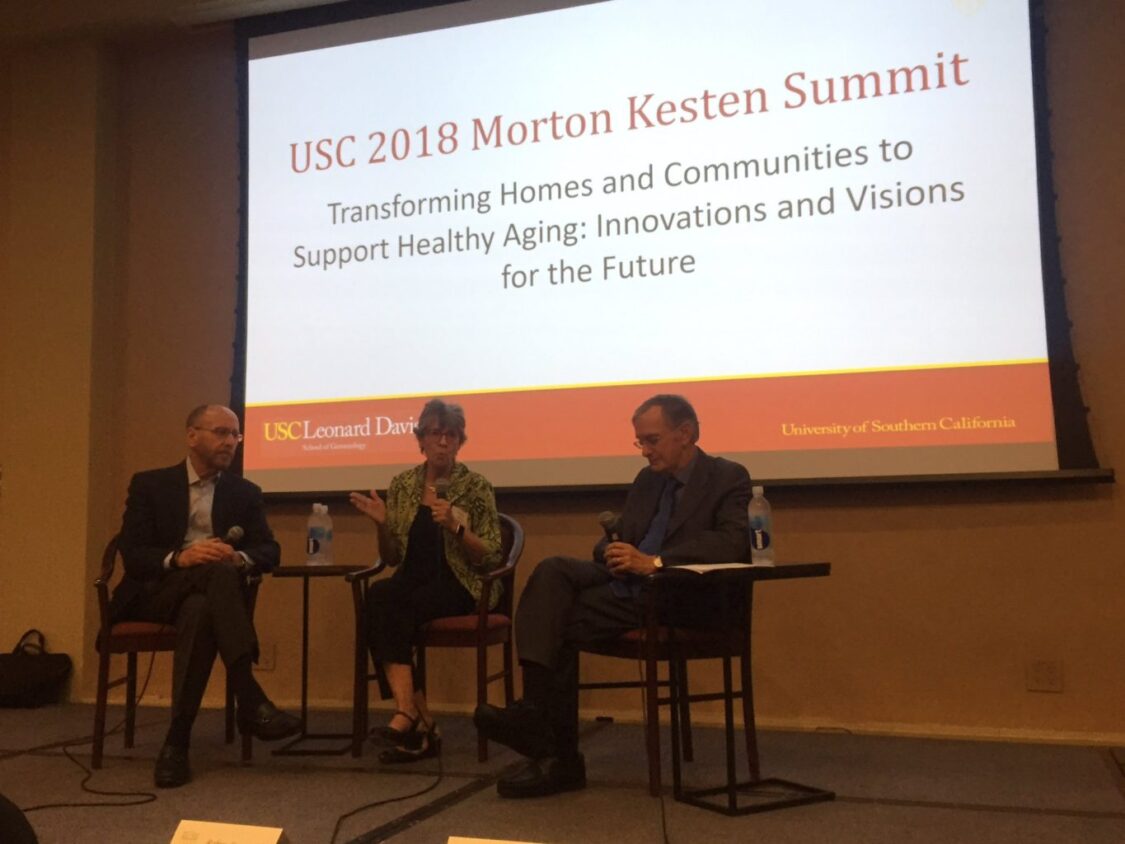The 2018 Morton Kesten Summit brought together experts in the field of gerontology to discuss making environments more age-friendly.
“This room represents an impressive group of providers, administrators, and professionals that play a key role in supporting aging in place in our communities across the United States and across the lifespan,” said Pinchas Cohen, dean of the USC Leonard Davis School of Gerontology, in his opening remarks.
The keynote panel focused specifically on how to transform homes and communities to support healthy aging.
“Housing and communities matter for older adults,” said Jon Pynoos, UPS Foundation Professor of Gerontology, Policy and Planning at the USC Leonard Davis School, who organized the event.
“Our zip code can have more impact on our health and well-being than our genetic code. Where we live matters,” said Reginald Tucker-Seeley, Edward L. Schneider Assistant Professor at the USC Leonard Davis School.
Here are a few more key takeaways:
What’s Working
Fall Prevention Programs
Kathleen Cameron, the director at the National Falls Prevention Resource Center within the National Council on Aging, highlighted programs and resources for preventing falls or their potential causes in a holistic way.
“Falls are largely preventable,” Cameron said. The National Falls Prevention Resource Center has information for consumers and professionals on how to reduce fall risks.
Emily Nabors, program manager for the USC Fall Prevention Center of Excellence, discussed home modification to prevent falls.
“Home modification can make daily activities easier, reduce accidents and support independent living,” Nabors said.
Nabors mentioned the importance of upskilling a workforce for home modification and suggested that professionals from the aging, disability, housing, and health care sectors get trained on the importance and benefits of home modification for aging in place through programs such as USC’s Executive Certificate in Home Modification Program.
Cameron’s and Nabors’ sentiments align, suggesting that older adults should be planning ahead to age in supportive home environments, monitor their medications, and have a physical activity plan in place to prevent falls.
The CAPABLE Model
The Johns Hopkins University School of Nursing has developed a promising evidence-based program called Community Aging in Place: Advancing Better Living for Elders, or CAPABLE. Francesca Salipur and Kendell M. Cannon from the Stanford University School of Medicine, who have worked on a pilot of the program, described its results of increasing participants’ ability to conduct daily activities and reducing depression, home hazards, and costs to Medicare and Medicaid.
“The CAPABLE model for building independence focuses on what matters most for each individual,” Cannon said.
Europe’s Innovative Age-Friendly Communities
Kathleen Wilber, the Mary Pickford Foundation Professor of Gerontology at the USC Leonard Davis School, cited Europe as a source for stellar examples of how communities can serve older adults.
“Local transportation is free for everyone over 65 in Ireland,” said Wilber. Wilber called the city of Manchester the mecca of activity and learning for older adults, where they drive age-friendly policies for themselves.
Wilber said we should take co-design cues from our friends across the pond.
“Older adults must actively participate in determining what they want, as they do in Europe,” she said.
Area to Improve: Housing for Older Adults in Los Angeles
Caroline Cicero, instructional associate professor of gerontology at the USC Leonard Davis School, said that Los Angeles is lacking in its amount of intergenerational housing and dementia-friendly housing. This makes it difficult for families to live together and care for each other and for individuals hoping to live and take care of themselves alone.
“More than 20 percent of L.A.’s homeless population is comprised of older adults,” she added.
Housing help could come in the form of 10,000 accessory dwelling units — secondary housing units that share the building lot of a primary house — that the city hopes to add by 2021, she said.
When it comes to new construction, Rosemarie Rossetti from the Universal Design Living Laboratory encouraged architects and planners to consider including universal design before construction starts so that buildings can be as supportive as possible.
“Doing it right from the beginning, with small differences like wider doorways and varied vanity heights, can add big value,” Rossetti said.
What the Future Holds
Using Technology to Age in Place
Aaron Hagedorn, instructional associate professor of gerontology at the USC Leonard Davis School, shared ideas of how to help older adults with technology innovations.
“The Apple Watch has lots of features that make tasks easier for older adults,” Hagedorn said.
Hagedorn also said that virtual reality gives people the ability to be anyone and to go anywhere, which has the potential to be transformative.
Aging Within Communities
Robyn Stone, the senior vice president of research at LeadingAge in Washington, D.C., and Paul Irving, USC Leonard Davis School distinguished scholar in residence and chairman of the Milken Institute’s Center for the Future of Aging, stressed the importance of involving the larger community in shaping the future of healthy aging.
They agreed that creating a relationship between the public and private sector is crucial to helping push policy change: a slow, nearly impossible process.
Both said that, regardless of age, everyone should support universal design and recognize the benefits of affordable housing.
“Young people and older people are both impacted by the high cost of housing. We have much more in common than we do apart,” Irving said.
Rodney Harrell, the director of Livable Communities at the AARP Public Policy Institute, said these issues transcend age barriers more than one might initially believe.
“Boomers and Millennials are not that different. They both want housing with amenities and access,” Harrell said.
The Morton Kesten Summit addresses the needs of individuals aging in place. The bi-annual Summit and associated Universal Design Competition are endowed by a family member in memory of the late Morton Kesten, an executive of Colonial Penn Insurance Co. at the time it was servicing AARP.





